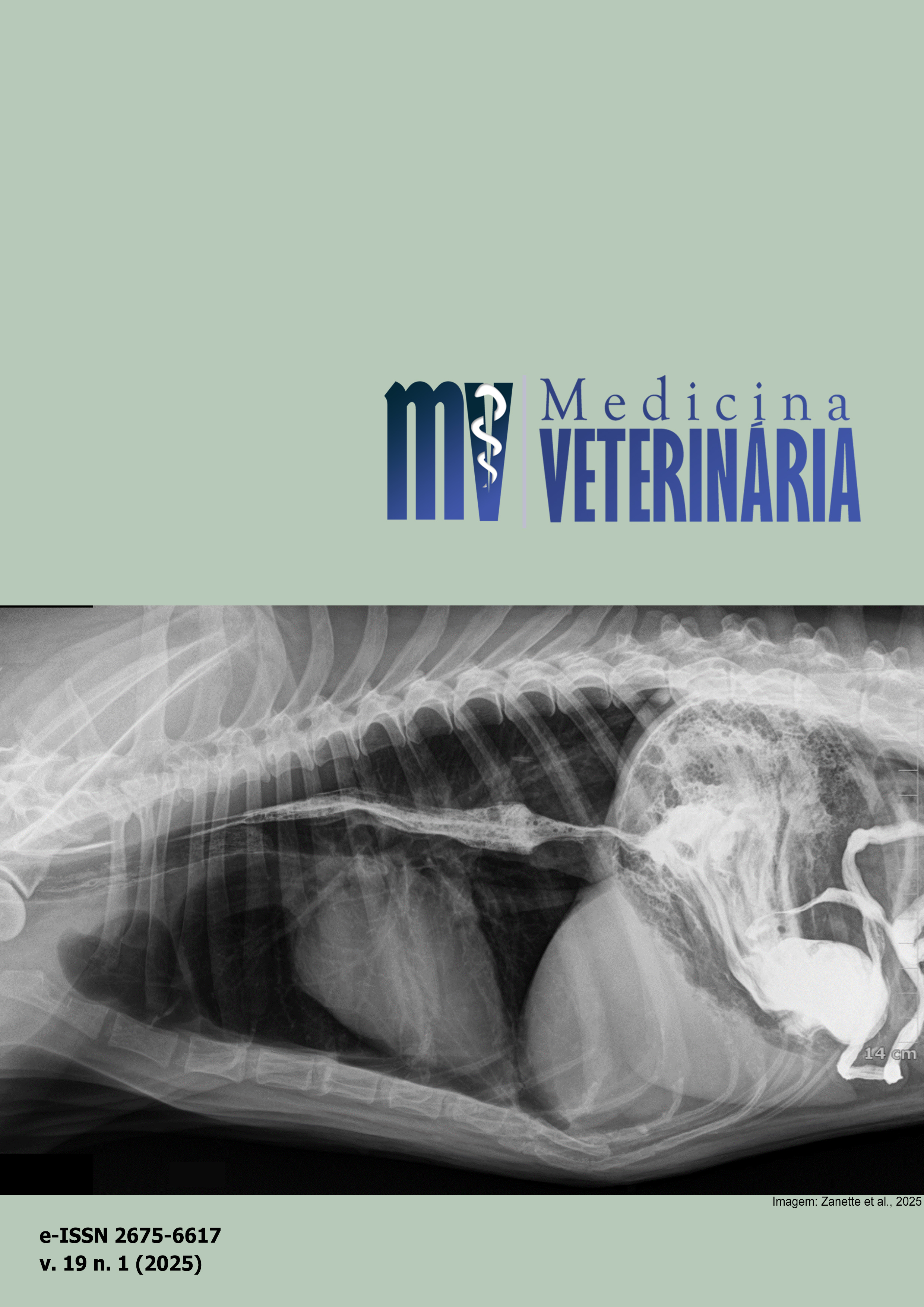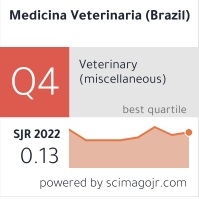Subdermal rotation flap for reconstruction of the periorbital region in a dog with soft tissue sarcoma
DOI:
https://doi.org/10.26605/medvet-v19n1-6821Keywords:
facial, flap, reconstructive, tumorAbstract
Soft tissue sarcomas (STM) are malignant neoplasms that originate from mesenchymal cells, mainly affecting the skin and subcutaneous tissue. It presents an invasive characteristic, which is the main reason for surgical removal with wide margins, thus often requiring reconstructive techniques to close these defects. Aimed to report a case of facial reconstruction using a rotational subdermal pattern flap in a 15-year-old mixed breed dog, taken to the Veterinary Hospital of the Federal Rural University of Pernambuco, with the main complaint of an increase in volume near the right eye. Through complementary exams such as cytology, face and chest radiography, histopathology and abdominal ultrasound, the animal was diagnosed with grade I soft tissue sarcoma in the periorbital region, without bone involvement in the region, nor metastatic signs. Aggressive tumor resection and facial reconstruction with a subdermal rotational flap were chosen. The patient returned for post-surgical evaluation in four days showing good progress, with no sign of flap involvement, and on the 16th day, the stitches were removed, due to excellent healing of the surgical wound. The reconstructive technique proved to be effective in treating large surgical wounds left after the removal of facial neoplasms.Downloads
References
Bray, J.P. Soft tissue sarcoma in the dog - Part 2: surgical margins, controversies and a comparative review. Journal of Small Animal Practice, 58(2):63-72, 2017.
Castro, P.F.;Campos, A.G.; Matera, J.M. Sarcoma de tecidos moles em cães: a ressecção cirúrgica cura?. Revista de Educação Continuada em Medicina Veterinária e Zootecnia do CRMV-SP, 17(2): 48-54, 2019.
Dickinson, I.C.; Whitwell, D.J.; Battistuta, D. et al. Surgical Margin and its influence on survival in soft tissue sarcoma. ANZ Journal of Surgery, 76: 104–109, 2016.
Hohenhaus, A.E.; Kelsey, J.L.; Haddad, J. et al. Canine cutaneous and subcutaneous soft tissue sarcoma: an evidence-based review of case management. Journal of the American Animal Hospital Association, 52(2):77-89, 2016.
Kirpensteijn, J.; Terhaar, G. Reconstructive surgery and wound management of the dog and cat. 1st ed. Londres: CRC Press, 2013. 240p.
Mcsporran, K.D. Histologic Grade Predicts Recurrence for Marginally Excised Canine Subcutaneous Soft Tissue Sarcomas. Veterinary Pathology, 46(5): 928-933, 2016.
Moreira, A.R.C. de A. (2021) Dissertação. Estudo de fatores clínico-patológicos em cães com sarcomas de tecidos moles cutâneos e subcutâneos. Universidade Estadual Paulista (Unesp). 67p.
Obradovich, J.E. Small Animal Clinical Oncology. 6th ed. Philadelphia: Saunders, 2016. 864p.
Silveira, M.F.; Gamba, C.O.; Guim, T.N. et al. Características epidemiológicas de sarcomas de tecidos moles caninos e felinos: levantamento de 30 anos. Revista Acadêmica Ciência Animal, 10(4): 361-365, 2012.
Tobias, K.M. Manual of small animal soft tissue surgery. 2nd ed. New Jersey: John Wiley & Sons, 2017. 624p.
Villalobos, A. Canine and feline geriatric oncology: honoring the human-animal bond. 2nd ed. New Jersey: John Wiley & Sons, 2017. 520p
Williams, J.; Moores, A. BSAVA Manual of Canine and Feline Wound Managementand Reconstruction. Gloucester: British Small Animal Veterinary Association, 2nd ed., 2002. 200p.
Downloads
Published
How to Cite
Issue
Section
License
Copyright (c) 2025 Maria Clara Cunha Paranhos de Oliveira, Grazielle Anahy Sousa Aleixo Cavalcanti, Karine Silva Camargo, Nathalia Vanessa Saraiva Lima, Robério Silveira de Siqueira Filho, Letícia Cibele Lima, Lilian Sabrina Silvestre Andrade, Fabrício Bezerra de Sá, Karollyne Andrade dos Santos Farias

This work is licensed under a Creative Commons Attribution-NonCommercial-ShareAlike 4.0 International License.
A Revista de Medicina Veterinária permite que o autor retenha os direitos de publicação sem restrições, utilizando para tal a licença Creative Commons CC BY-NC-SA 4.0.
De acordo com os termos seguintes:
Atribuição — Você deve dar o crédito apropriado, prover um link para a licença e indicar se mudanças foram feitas. Você deve fazê-lo em qualquer circunstância razoável, mas de nenhuma maneira que sugira que o licenciante apoia você ou o seu uso.
NãoComercial — Você não pode usar o material para fins comerciais.
CompartilhaIgual — Se você remixar, transformar, ou criar a partir do material, tem de distribuir as suas contribuições sob a mesma licença que o original.
Sem restrições adicionais — Você não pode aplicar termos jurídicos ou medidas de caráter tecnológico que restrinjam legalmente outros de fazerem algo que a licença permita.







